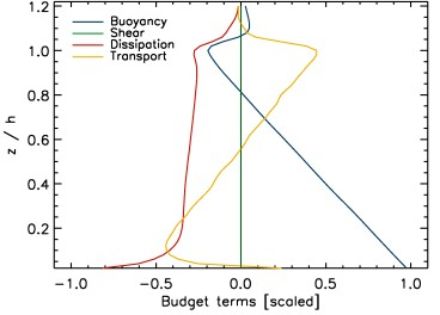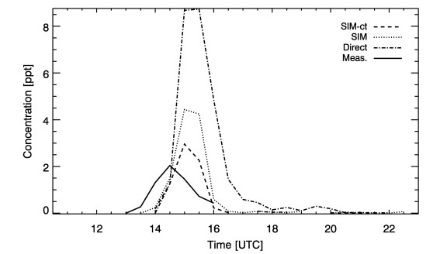Service Navigation
Search
Enhancing mesoscale meteorological modelling capabilities for air pollution and dispersion applications

The general aim of this work is to better understand and improve the coupling between numerical weather prediction (NWP) and dispersion models. In most cases, the driving NWP models do not provide all the variables which are required by the dispersion simulation. Consequently, an interface or meteorological pre-processor is used between these two models, which derives all the necessary - in most cases turbulence related - variables. To further investigate the role of pre-processors, a detailed intercomparison of the post-diagnosed turbulence characteristics with measurements, Large Eddy Simulation data and similarity theory approaches is performed. Impacts of different coupling approaches to the dispersion process are tested with the Lagrangian particle dispersion model LPDM of the German Weather Service. This model is coupled off-line with the COSMO model, which is used operationally at MeteoSwiss for numerical weather prediction.
Data & Methods
The main objective of the COST Action 728 is to develop an advanced conceptual and computational framework to enhance significantly European capabilities in mesoscale meteorological modelling for air pollution and dispersion applications.
Models applied for the transport and diffusion of air pollutants in emergency situations show great variability, ranging from the simplest Gaussian plume models based on in situ meteorological measurements to the most sophisticated Lagrangian particle dispersion models driven by numerical weather prediction (NWP) models. All these modelling systems have three main components. On the one hand, detailed information is required from the atmospheric conditions, where the dispersion process takes place. This can be obtained e.g. by the use of observations or by complex NWP models. On the other hand, a dispersion model is needed to consider all the processes related to transport and diffusion of air pollutants. In most cases the meteorological measurements or the driving models do not provide all the variables that are required by the dispersion model, and consequently, a meteorological pre-processor has to be used as an interface between these two models which derives all the necessary - in most cases turbulence related - parameters.
The general aim of this work is to better understand and improve the coupling between numerical weather prediction and dispersion models. For this, all the three main components of the modelling system have to be investigated: The NWP model, the dispersion model and the coupling interface. At MeteoSwiss the COSMO model is used to produce weather forecasts and also to drive the dispersion model, which is the Lagrangian particle dispersion model (LPDM) of the German Weather Service. In the framework of the COST Action 728, a new external coupling interface was developed for LPDM, which enables an easy choice between different turbulence parameterizations [1].
The three components of the modelling system were evaluated on selected case studies. A continuous verification of turbulence related parameters would have been very difficult, as these parameters are usually not measured on a regular basis. The selection of appropriate cases was also a difficult task, as the detailed turbulence parameters and the tracer dispersion properties are nearly never measured in a single measurements campaign. Consequently, for the validation of all the three modelling components, different case studies were chosen.
The capability of the COSMO model for simulating the mean and turbulence properties of the planetary boundary layer (PBL), where the transport and diffusion of air pollutants takes place, was investigated withree case studies. First, an idealized dry convective case was studied for which reliable large eddy simulation data was available [2]. Secondly, a real dry convective case was chosen from the LITFASS-2003 measurement campaign, which is characterized by highly heterogeneous surface conditions. Finally, to get a full picture from the COSMO model's turbulence scheme, the GABLS-3 real stable case was also investigated. The interfacing method between the NWP and the dispersion model was tested on a longer measurement campaign, in the framework of the CN-MET Project. As an achievement of this project, four sonic anemometers were mounted at the locations of the Swiss nuclear power plants at 10 meters height. Different interfacing approaches were validated using three-month time series from these sensors. The impact of different interfacing approaches on the concentration results was evaluated on the TRANSALP-89 tracer experiment, which was conducted in highly complex terrain in southern Switzerland.
Scientific Results



The performance of the COSMO models turbulence scheme was tested in several case studies. The investigation of an ideal convective case showed several important drawbacks of the scheme [3]. As our goal was to understand the behaviour of the turbulence scheme in details, it was not enough to verify the predicted Turbulent Kinetic Energy (TKE), which is the main turbulence variable of COSMO, but the sources and sinks of the TKE budget had to be analyzed separately. The results show that the turbulent transport of TKE is too weak in the COSMO model, compared to the LES results (Figure 1). Consequently, TKE values at the top of the planetary boundary layer (PBL) are low and the negative buoyancy flux in the entrainment zone is nearly completely missing. The improvement of the turbulence scheme on the basis of this analysis is subject to ongoing work at MeteoSwiss.
Turbulence characteristics diagnosed by the coupling interface were also verified using measurement data from the CN-Met Project. The verification results show an overall good performance of the modelling system (Figure 2), with all the selected turbulence parameters being in an acceptable range (20-30% relative bias).
Turbulent kinetic energy, which is the only turbulence related model variable in COSMO, is generally underestimated by the model. Two different approaches for the post-diagnosis of turbulence variables, as required by the LPDM dispersion model, were compared. Very good performance was observed in the case of vertical turbulence, which is the most important turbulence variable with respect to mesoscale dispersion modelling.
The standard deviations of horizontal wind speed are not as well predicted as that for the vertical component. The method based on similarity theory shows slightly better performance than that based on the direct use of TKE from the COSMO model. The turbulence variables used by ENSI (Swiss Federal Nuclear Safety Inspectorate) are also predicted well by the COSMO model, with a moderate underestimation of the standard deviation of wind direction.
First, the impact of diagnosed turbulence characteristics on the dispersion process was evaluated on hypothetical pollutant releases (Figure 3). Results show that the different interfacing approaches can lead to substantial changes in the forecasted concentrations, with the method based on the direct usage of TKE resulting in lower concentrations [4].

The scaling relationships used in dispersion modelling systems are usually based on turbulence datasets over flat and homogeneous surface. However, turbulence structure in complex terrain, such as in steep and narrow Alpine valleys, can be substantially different from flat conditions. In this work, a first attempt was made to account for the modified turbulence characteristics in complex terrain, and a new scaling approach suited for steep and narrow Alpine valleys [5] was investigated with respect to pollutant dispersion [6]. The new approach was tested on the TRANSALP-89 tracer experiment which was conducted in highly complex terrain in southern Switzerland. The sensitivity of the modelling system towards the soil moisture, horizontal grid resolution, and boundary layer height determination was investigated. It was shown that if the flow field is correctly reproduced the new scaling approach improves the tracer concentration simulation, when compared to the classical coupling methods (Figure 4).

2009
[1] Szintai, B., and O. Fuhrer, 2009: Component testing of the COSMO model's turbulent diffusion scheme. COSMO Newsletter No. 9, 37-41.
[2] Szintai, B., Kaufmann, P., and M. W. Rotach, 2009: Deriving turbulence characteristics from the COSMO numerical weather prediction model for dispersion applications. Advances in Science and Research, 3, 79-84.
[3] Szintai, B., Kaufmann, P., and M. W. Rotach, 2009: Simulation of pollutant transport in complex terrain with a NWP - particle dispersion model combination. Bound.-Layer Meteor., submitted.
2008
[4] Szintai, B., and P. Kaufmann, 2008: TKE as a measure of turbulence. COSMO Newsletter No. 8, 2-9.
2007
[5] Weigel, A. P., Chow, F. K., and Rotach, M. W., 2007: On the nature of turbulent kinetic energy in a steep and narrow Alpine valley. Bound.-Layer Meteor., 123, 177-199.
2000
[6] Mironov, D. V., Gryanik, V. M., Moeng, C.-H., Olbers, D. J., and Warncke, T. H., 2000: Vertical turbulence structure and second-moment budgets in convection with rotation: A large-eddy simulation study. Quart. J. Roy. Meteor. Soc, 126, 477-515.